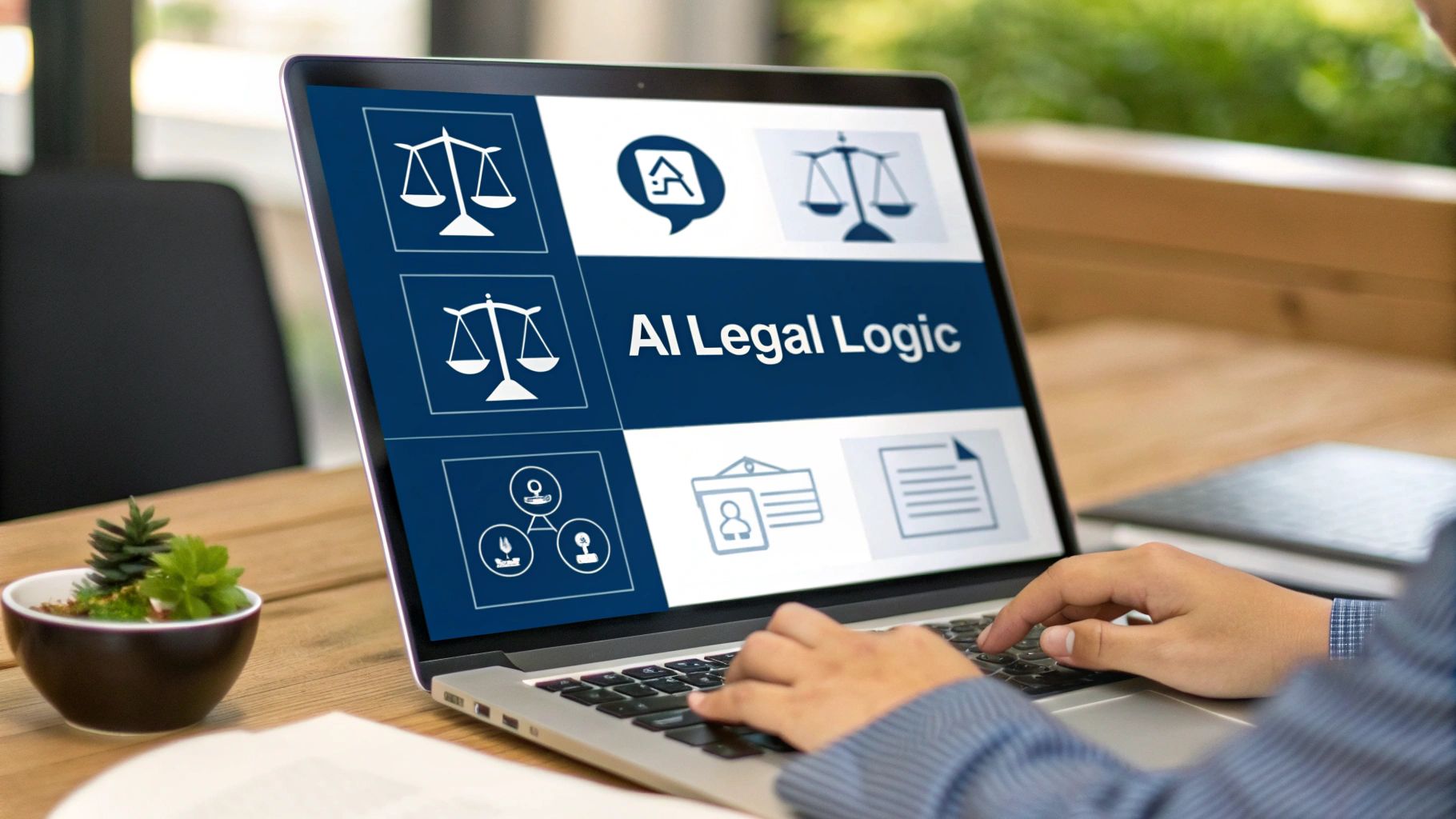AI Legal Assistant: A Strategic Guide to Transforming Modern Law Practice
Navigating the AI Revolution in Legal Practice

The legal field is fundamentally changing as AI legal assistants become essential tools for modern practice. Recent data highlights this dramatic shift - according to Clio's 2024 Legal Trends Report, AI adoption among legal professionals surged from 19% to 79% in just one year. This rapid increase raises an important question: How are successful law firms effectively implementing these new technologies while maintaining high standards of practice?
Balancing Automation with Legal Expertise
The key to successful AI integration lies in finding the right mix between automated efficiency and professional judgment. AI tools excel at handling routine tasks like document review and research, allowing attorneys to focus on complex analysis, strategy development, and meaningful client interactions. However, human oversight remains essential - lawyers must carefully review AI-generated work and ensure all ethical guidelines are followed. This balanced approach helps firms improve productivity while maintaining the highest standards of legal practice.
The Rise of North America in AI Legal Tech
North America has emerged as the clear leader in adopting AI legal technology, currently holding 46% of the market share in 2024. This dominance stems from several factors, including established legal tech infrastructure, strong venture capital support for AI development, and a culture of innovation within the legal community. The region's large, complex legal market creates strong demand for tools that can handle sophisticated legal work efficiently. Industry analysts expect this growth trend to continue as more firms recognize the competitive advantages of AI adoption.
Evaluating Your Firm's AI Readiness
Before implementing AI solutions, firms need to carefully assess their current capabilities and specific needs. Start by examining existing workflows to identify which tasks would benefit most from automation. Next, review your technical infrastructure to determine what updates might be needed to support AI tools effectively. Finally, develop a comprehensive training plan to ensure your team understands both the technical aspects and ethical considerations of using AI in legal practice. This structured approach helps firms make informed decisions about AI adoption.
Impact on Client Service Delivery
The integration of AI tools directly improves how firms serve their clients. By reducing time spent on routine tasks, lawyers can respond more quickly to client needs and focus on providing strategic guidance. AI also helps ensure consistency and accuracy across legal documents and research, leading to better outcomes for clients. These improvements often result in more cost-effective service delivery, opening possibilities for new billing models that better reflect the value provided to clients while maintaining profitability.
Mastering Your AI Legal Assistant's Capabilities
Building on the client service improvements discussed earlier, today's AI legal assistants have evolved far beyond basic automation tasks. Research shows that 89% of lawyers now use these tools for sophisticated work including deep case analysis, document review, and compliance monitoring. Let's explore how these key capabilities create real value for legal practices.
Predictive Case Analysis: Gaining an Edge in Litigation
AI-powered case analysis gives legal teams a strategic advantage by examining historical data to identify patterns and likely outcomes. For instance, the system can analyze past rulings, case law, and similar legal documents to assess the probability of success for a specific lawsuit. This enables more strategic decisions about litigation approach, settlement negotiations, and resource planning. Legal teams can better manage risk and deliver improved results by basing choices on comprehensive data analysis.
Automated Document Review: Efficiency and Accuracy Improved
Document review has traditionally consumed significant time and resources, but AI assistance changes this dynamic. The technology rapidly processes thousands of documents to identify key information, flag relevant evidence, and handle redactions - all faster and more precisely than manual review. This frees up attorney time while reducing errors, creating more efficient workflows that directly benefit clients through quicker turnaround and lower costs.
Regulatory Compliance Monitoring: Preventing Issues Proactively
Staying current with evolving regulations presents an ongoing challenge for legal practices. AI tools offer automated compliance monitoring that tracks legislative changes, spots potential issues, and generates compliance reports. This proactive approach helps prevent violations and penalties while allowing lawyers to focus on strategic guidance. Clients benefit from more effective risk management through early identification and resolution of compliance concerns.
Maximizing Your AI Legal Assistant Investment
Getting the most value from AI legal tools requires a thoughtful implementation strategy. Key success factors include carefully evaluating platforms based on specific needs, smoothly integrating new tools with existing processes, and providing ongoing training to help staff effectively combine AI capabilities with their legal expertise. When teams learn to blend technology with professional judgment, they can achieve optimal results while maintaining high ethical standards. Taking a systematic approach to selecting and adopting these tools positions firms to unlock their full potential.
Using AI Automation for Billable Legal Work

As firms explore ways to integrate AI legal assistants, the key challenge is finding the right balance between automation and quality control. While AI tools can significantly boost efficiency, implementing them effectively requires careful planning and oversight to maintain high standards of legal work.
Finding the Right Tasks for AI Automation
The first priority is identifying which legal tasks are best suited for AI assistance. Document review, basic legal research, and routine contract analysis are prime candidates since they involve processing large volumes of standardized information. By focusing AI tools on these repeatable tasks, attorneys can free up time for complex analysis and client strategy. This selective approach helps firms maximize the impact of automation while ensuring AI is used appropriately.
Implementing Quality Control Measures
Even with advanced AI tools, human oversight remains essential. Think of AI assistants as skilled paralegals who handle initial drafts and research - the attorney still needs to review and refine their work. Regular quality checks and feedback help improve the AI's performance over time. Setting up clear review processes ensures that automated work products meet the firm's standards while allowing attorneys to focus on higher-value activities that require their expertise.
Managing Client Communication and Expectations
Being upfront with clients about AI use builds trust and demonstrates a commitment to efficiency. Explaining specific ways that AI tools enhance services - like faster document review or more thorough research - helps clients understand the benefits. For example, showing how AI assists in analyzing thousands of documents quickly while maintaining accuracy can highlight how automation improves case handling. This transparent approach keeps clients informed while positioning the firm as forward-thinking.
Adapting Billing Models for AI Efficiency
As AI speeds up traditionally time-intensive tasks, firms need to rethink how they charge for services. The standard hourly billing model may not reflect the value provided when AI dramatically reduces completion time. Alternative approaches like flat-fee arrangements for specific services or value-based billing could better align with AI-enhanced efficiency. By proactively adjusting billing structures, firms can maintain profitability while passing some cost savings to clients. This balanced approach helps demonstrate the mutual benefits of thoughtful AI adoption.
Building a Successful AI Implementation Strategy
Bringing AI legal assistants into your practice requires careful planning that considers both technical capabilities and human needs. Success depends on much more than just selecting the right software - it requires rethinking workflows and giving your team the support they need through training, change management, and ongoing performance tracking.
Staff Training and Development: Key to AI Adoption
Getting your team up to speed is essential for successful AI implementation. A well-designed training program should cover both the technical aspects of using AI tools and their broader impact on legal work. Your team needs to understand how AI can improve legal research, speed up document review, and enhance client communications. Just as important is education about the ethical implications of using AI in law practice. This comprehensive approach ensures staff can use AI tools effectively while maintaining professional standards.
Change Management: Navigating the Transition Smoothly
Adding AI tools changes how your team works. Clear communication helps make this transition easier by explaining why you're implementing AI, what benefits to expect, and how roles may shift. Being transparent builds understanding and support. Make space for staff to voice concerns and participate in implementation decisions. When people feel heard and involved, they're more likely to embrace new ways of working.
Performance Monitoring and Feedback: Ensuring Optimal Results
Once your AI system is running, tracking its impact becomes crucial. Monitor metrics like time saved on tasks, accuracy rates, and client satisfaction scores. This data shows where the AI is working well and where it needs improvement. Regular feedback from users is equally important - their hands-on experience reveals practical challenges and opportunities to fine-tune the system. For example, staff input might highlight needs for focused training or adjustments to how the AI processes certain tasks.
Establishing Measurable Success Metrics
Set clear, quantifiable goals tied to what matters most for your firm. Different priorities require different measurement approaches. If you're focused on efficiency, track time saved on document review. For quality improvements, monitor error rates in AI-generated documents. Having concrete benchmarks helps prove the AI's value and supports decisions about future investments. This evidence-based approach keeps your AI implementation aligned with firm goals.
Evolving Your Business Model for AI Integration

Adding AI legal assistants to your practice requires rethinking key aspects of how your firm operates and makes money. This means carefully examining and updating your service delivery approach, pricing methods, and client communication strategies. While making these changes takes effort, they're essential for staying competitive as AI reshapes legal services.
Rethinking Service Delivery with AI Legal Assistants
AI tools open up exciting possibilities for expanding your service offerings. For example, you can now provide data-driven case outcome predictions as a premium service for clients wanting deeper insights. The time saved through AI also lets you take on more cases or offer more complete services at current rates. You may even branch into new practice areas or develop specialized expertise. To make this work, take time to map out where AI can improve existing services or create entirely new ones that clients value.
Adapting Pricing Models for AI-Driven Efficiency
The standard hourly billing approach often doesn't capture the full value of AI-enhanced legal work. Since AI speeds up tasks like document review significantly, charging only by the hour could actually reduce your revenue. Consider alternatives like flat fees for specific AI services such as contract analysis. You might also try value-based pricing tied to client outcomes - for instance, taking a percentage of settlements where AI played a key role. These models better reflect the benefits that AI brings to your practice.
Communicating Value and Building Client Trust
Be upfront with clients about how you use AI to serve them better. Focus on concrete benefits like faster turnaround times, more accurate work, and potential cost savings. Show real examples - like how AI can analyze thousands of documents for discovery far more quickly than manual review, saving both time and money. Address any concerns about AI's role directly to build trust and show that you're focused on using the best tools to help clients. Open dialogue helps clients understand and appreciate the value you provide.
Maintaining a Competitive Edge in the Evolving Legal Landscape
Law firms today must adapt to succeed as AI changes how legal work gets done. The firms that thoughtfully integrate AI into their practice while adjusting their business approach will stand out. They can deliver more efficient, cost-effective services that both attract new clients and keep existing ones happy by showing a commitment to using the best available tools. Regular assessment and refinement of your AI strategy helps maintain your competitive position and ensures you're getting maximum benefit from these powerful tools.
Preparing for the Next Wave of Legal AI Innovation

Law firms today need to stay ahead of rapid changes in AI technology to remain competitive. As AI legal tools become more advanced, firms must develop strategies to effectively evaluate and implement these new capabilities while maintaining high standards of service. Success requires a thoughtful approach that combines technical knowledge with professional judgment.
Identifying Emerging Trends in Legal AI
The legal technology landscape is shifting from basic automation to more sophisticated analysis. AI assistants now handle complex tasks like predictive case analysis and in-depth document review. At the same time, integration between AI and other technologies like blockchain and data analytics creates powerful new capabilities for legal work. Law firms need to actively monitor these developments and assess which tools can provide real value for their practice.
Evaluating and Implementing New AI Technologies
When considering new AI tools, firms should establish clear evaluation criteria covering both technical capabilities and ethical implications. The implementation process requires careful planning around workflow integration and comprehensive staff training. Training programs should address both practical usage and important limitations, emphasizing that AI serves to support rather than replace professional judgment. Success depends on methodical evaluation followed by strategic rollout.
Balancing Automation and Human Expertise
While AI excels at tasks like document review and legal research, human attorneys remain essential for complex analysis, strategy, and client relationships. The key is finding the right mix - using AI to handle routine work while preserving the irreplaceable human elements of legal practice. When implemented thoughtfully, AI amplifies attorney capabilities rather than diminishing the profession's core value.
Managing the Risks of AI Adoption
AI adoption requires careful attention to data security, especially given the sensitive nature of legal information. There are also important considerations around algorithmic bias and accuracy. Firms can address these challenges through rigorous vendor assessment, strong security protocols, and human oversight of AI outputs. A systematic approach to risk management helps ensure AI tools enhance rather than compromise legal services.
Whisperit, an AI-powered dictation and text editing platform, offers a secure and efficient solution for document creation and management. Designed for professionals in legal, healthcare, and other sectors, Whisperit leverages advanced AI models to streamline workflows and boost productivity. Learn more about how Whisperit can transform your document-heavy tasks at https://whisperit.ai.